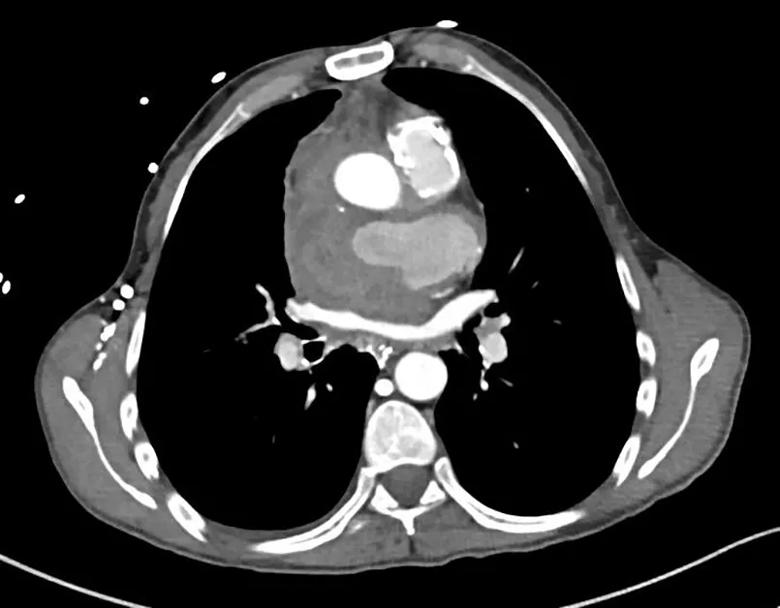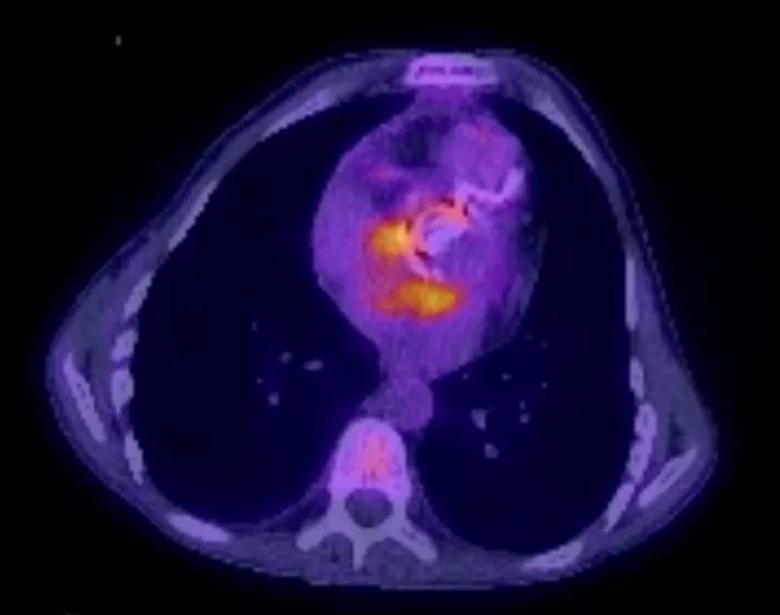Fever and aortic root bleeding two decades post-Ross procedure
A man in his 30s with a history of four prior heart operations presented at Cleveland Clinic from out of state. He had undergone a Ross procedure as a child for rheumatic heart disease. This was followed by repair of his aortic and mitral valves, then by replacement of his bioprosthetic aortic valve with a mechanical valve the following year, and then by replacement of his aortic valve, aortic root and pulmonary valve a number of years later for an aneurysm of the autograft.
Advertisement
Cleveland Clinic is a non-profit academic medical center. Advertising on our site helps support our mission. We do not endorse non-Cleveland Clinic products or services. Policy
Prior to his current presentation, he developed a pseudoaneurysm originating from the left coronary artery button of the aortic root shortly after his fourth operation. However, his surgeons were reluctant to operate again and decided to monitor the pseudoaneurysm, which was deemed to be slow-growing. When he eventually developed an infection and fever, the need for surgery became urgent. When told the surgery carried a high mortality rate, he came to Cleveland Clinic to see if his case would be taken.
CT scan (Figure 1) revealed a large pseudoaneurysm where the left main artery had been reimplanted into the aorta in a prior surgery. A subsequent PET scan (Figure 2) revealed a large area of uptake around the aortic root thought to be secondary to an infectious process. Imaging also showed that the pseudoaneurysm was compressing the superior vena cava and causing occlusion.

Figure 1. CT scan at presentation showing a large (8-cm) pseudoaneurysm posterior to the aortic root with associated compression of the right pulmonary artery and left and right atria, as well as occlusion of the superior vena cava.

Figure 2. PET scan showing a large area of uptake in the mediastinum likely due to an infectious/inflammatory process.
He underwent infectious disease evaluations while being treated with intravenous antibiotics. After multidisciplinary consultation, the care team decided to proceed with high-risk surgery and the patient gave consent.
Cardiothoracic surgeon Shinya Unai, MD, opened the patient’s chest and removed the previously placed aortic root, all graft material, the pulmonary homograft and the valve that was implanted inside. “We removed all the previous surgical material so that we could ensure control of the infection,” he says.
Advertisement
Dr. Unai replaced the aortic valve and root with an On-X® aortic valved conduit and placed a homograft in the pulmonary valve position. The superior vena cava was also reconstructed to address its occlusion.
The operation proceeded smoothly without major bleeding or postoperative complications. The patient was discharged home 12 days later on oral antibiotics, which were subsequently discontinued. He was faring well at three-month follow-up and will return to Cleveland Clinic yearly for follow-up with cardiologist Benico Barzilai, MD.
“The Ross procedure is a great operation if done well,” notes Dr. Unai. “It should only need to be performed once in a lifetime. When it fails, it can lead to a series of reoperations, as this patient’s case makes clear. For this reason, when a Ross fails, the best course is to seek care at an advanced heart center.”
Aortic root aneurysms can develop after a Ross procedure, Dr. Unai adds, noting that pulmonary tissue is not as strong as aortic tissue and does not withstand high pressure as well. Root dilation is one reason a Ross procedure can fail.
“We typically wrap the autograft with native aortic tissue to provide an extra layer of protection,” Dr. Unai says. “There are many different techniques to ensure a Ross procedure will be a long-lasting operation. Although a technically demanding operation, we have learned over the years how to perform the Ross procedure safely with a durable result. ”
For Dr. Barzilai, who has overseen the patient’s cardiology care since the fifth operation profiled above, the key takeaway from this case is to not let reluctance about a further reoperation prevent referral when indicated.
Advertisement
“The patient’s pseudoaneurysm had grown so huge that it was obstructing the pulmonary artery, encroaching on the left and right atria, and occluding the vena cava,” he says. “Reluctance about an additional operation is understandable, but given the growth of the pseudoaneurysm, referral for surgery before he developed infection and fever would have been reasonable and made management less risky. Fortunately, a good outcome was still achievable.”
Advertisement
Advertisement

End-of-treatment VALOR-HCM analyses reassure on use in women, suggest disease-modifying potential

New Cleveland Clinic data challenge traditional size thresholds for surgical intervention

3 specialists share multidisciplinary perspectives on a widely impactful cardiovascular condition

Experience-based takes on valve-sparing root replacement from two expert surgeons

Two surgeons share insights on weighing considerations across the lifespan

Join us in Florida this winter for a long-standing CME favorite

BITA grafts themselves are rarely to blame, and outcomes can be good

First-in-human phase 1 trial induced loss of function in gene that codes for ANGPTL3